winter tires AUDI A6 2018 Owners Manual
[x] Cancel search | Manufacturer: AUDI, Model Year: 2018, Model line: A6, Model: AUDI A6 2018Pages: 266, PDF Size: 41.38 MB
Page 67 of 266
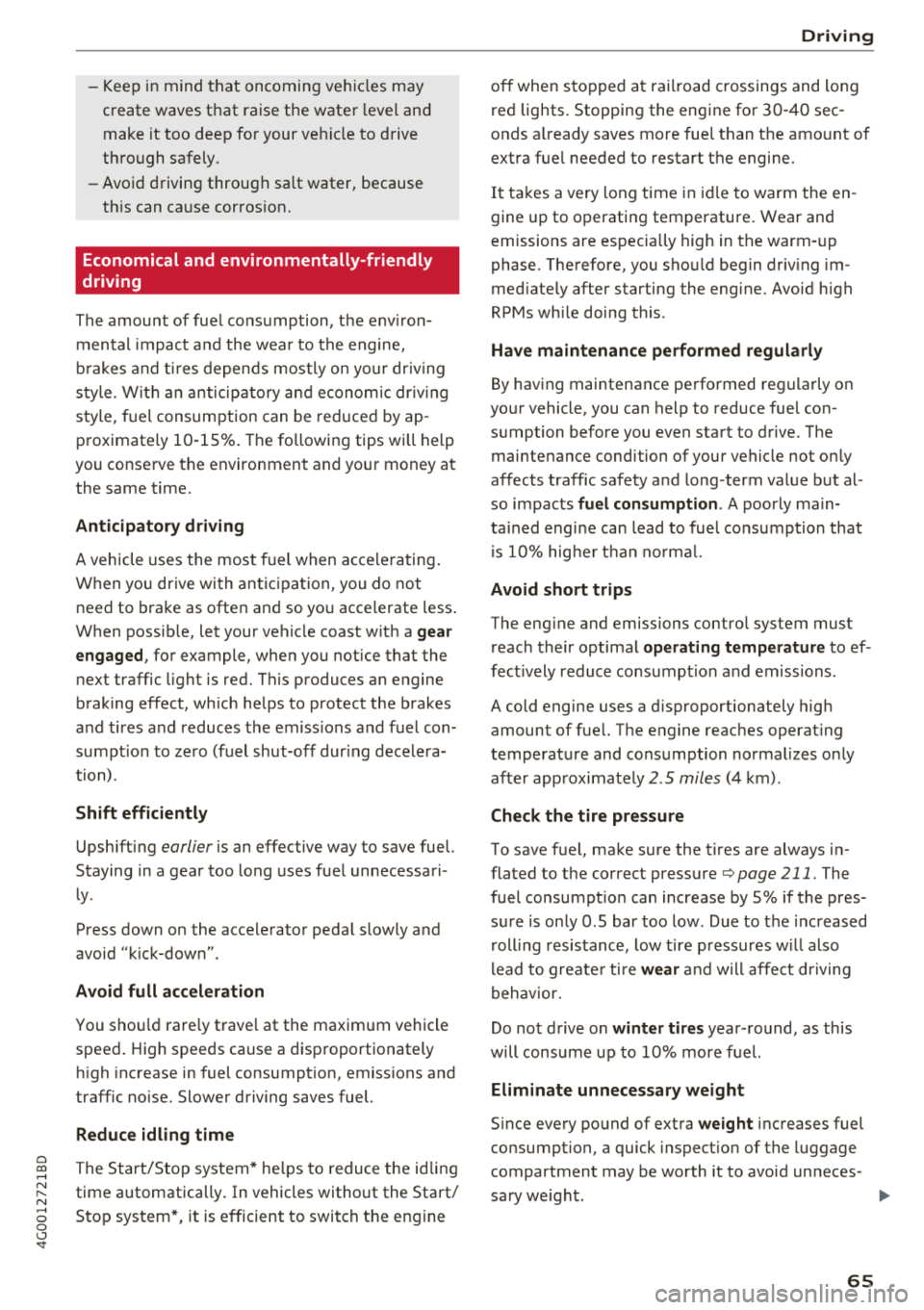
a co .... N
" N
-Keep in mind that oncoming vehicles may
create waves that raise the water level and
make it too deep for your vehicle to drive
through safely.
-Avoid driving through salt water, because
this can cause corrosion.
Economical and environmentally-friendly
driving
The amount of fuel consumption, the environ
mental impact and the wear to the engine,
brakes and tires depends mostly on your driving
style. With an anticipatory and economic driving
style, fuel consumption can be reduced by ap
proximately 10-15%. The following tips will help
you conserve the environment and your money at the same time.
Anticipatory driving
A vehicle uses the most fuel when accelerating.
When you drive with anticipation, you do not
need to brake as often and so you accelerate less.
When possible, let your vehicle coast with a
gear
engaged, for example, when you notice that the
next traffic light is red. This produces an engine
braking effect, which helps to protect the brakes
and tires and reduces the emissions and fuel con
sumption to zero (fuel shut-off during decelera
tion) .
Shift efficiently
Upshifting earlier is an effective way to save fuel.
Staying in a gear too long uses fuel unnecessari
ly .
Press down on the accelerator pedal slowly and
avoid "kick-down".
Avoid full acceleration
You should rarely travel at the maximum vehicle
speed. High speeds cause a disproportionately
high increase in fuel consumption, emissions and
traffic noise. Slower driving saves fuel.
Reduce idling time
The Start/Stop system* helps to reduce the idling
time automatically. In vehicles without the Start/
8 Stop system*, it is efficient to switch the engine 0 \.J '
off when stopped at railroad crossings and long
red lights. Stopping the engine for 30-40 sec
onds already saves more fuel than the amount of
extra fuel needed to restart the engine.
It takes a very long time in idle to warm the en
gine up to operating temperature. Wear and
emissions are especially high in the warm-up
phase. Therefore, you should begin driving im
mediately after starting the engine. Avoid high
RPMs while doing this .
Have maintenance performed regularly
By having maintenance performed regularly on
your vehicle, you can help to reduce fuel con
sumption before you even start to drive. The maintenance condition of your vehicle not only
affects traffic safety and long-term value but al
so impacts
fuel consumption . A poorly main
tained engine can lead to fuel consumption that
is 10% higher than normal.
Avoid short trips
The engine and emissions control system must
reach their optimal operating temperature to ef
fectively reduce consumption and emissions .
A cold engine uses a disproportionately high amount of fuel. The engine reaches operating
temperature and consumption normalizes only
after approximately
2 .5 miles (4 km) .
Check the tire pressure
To save fuel, make sure the tires are always in
flated to the correct pressure
Q page 211. The
fuel consumption can increase by S% if the pres
sure is only 0.5 bar too low . Due to the increased
rolling resistance, low tire pressures will also
lead to greater tire
wear and will affect driving
behavior.
Do not drive on
winter tires year -round, as this
will consume up to 10% more fuel.
Eliminate unnecessary weight
Since every pound of extra weight increases fuel
consumption, a quick inspection of the luggage
compartment may be worth it to avoid unneces -
sary weight.
.,.
65
Page 83 of 266
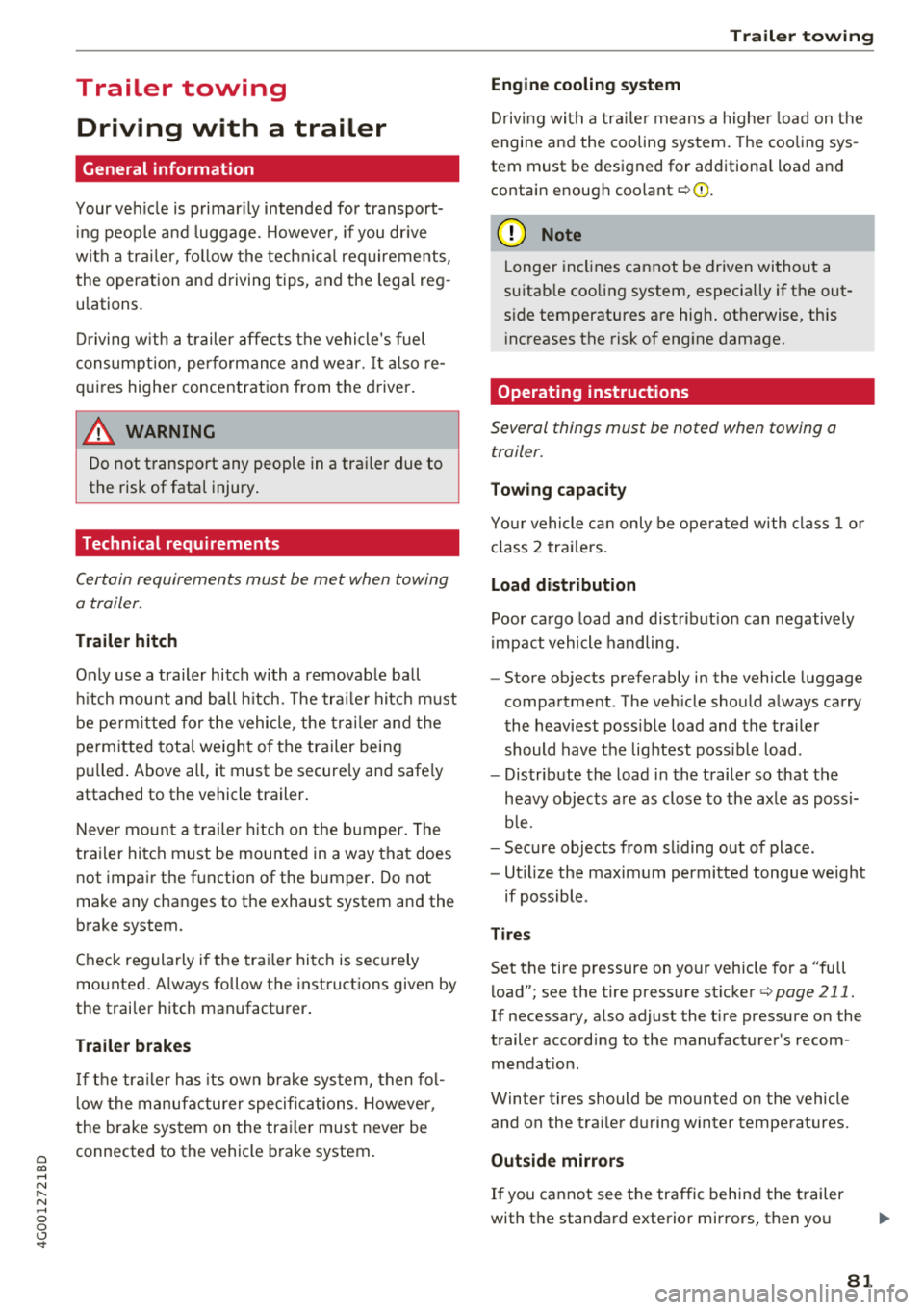
a co .... N
" N .... 0 0 \.J -
General information
Your veh icle is primar ily intended for transport
ing people and luggage. However, if you dr ive
with a trailer, follow the technical requirements,
the operation and driving tips, and the legal reg
u lations.
Driving with a trailer affects the vehicle 's fuel
consumption, performance and wear. It also re
quires highe r concentration from the driver.
A WARNING
Do not transport any people in a trailer due to
the risk of fatal injury.
Technical requirements
Certain requirements must be met when towing
a trailer.
Trailer hitch
Only use a trailer hitch with a removab le ball
hitch mount and ball hitch. The trailer hitch must
be perm itted for the vehicle, the trailer and the
permitted total weight of the trailer being
pu lled. Above all, it must be secure ly and safe ly
attached to the vehicle trailer.
Never mount a trailer hitch on the bumper. The
trailer hitch must be mounted in a way that does
not impair the function of the bumper. Do not
make any changes to the exhaust system and the
brake system.
Check regularly if the trailer hitch is securely
mounted. A lways follow the instructions given by
the trai ler hitch manufacturer .
Trailer brakes
If the tra iler has its own brake system, then fol
l ow the manufacturer specifications. However,
the brake system on the trailer must never be
connected to the vehicle brake system.
Trailer towing
Engine cooling system
Driving with a trailer means a higher load on the
engine and the cooling system. The coo ling sys
tem must be designed for additiona l load and
contain enough coo lant
i::> @ .
@ Note
Longer inclines cannot be driven without a
suitab le cooling system, especia lly if t he out
side temperatures are high . otherwise, this
increases the risk of engine damage.
Operating instructions
Several things must be noted when towing a
trailer.
Towing capacity
Your vehicle can only be operated with class 1 or
class 2 trailers.
Load distribution
Poor cargo load and distribut ion can negatively
impact vehicle handling.
- Store objects preferably in the vehicle luggage
compartment . The vehicle should always carry
the heaviest poss ible load and the trailer
should have the lightest possible load.
- Distribute the load in the trailer so that the
heavy objects are as close to the axle as poss i
b le.
- Secure objects from sl iding out of place .
- Ut ilize the maximum permitted tongue weight
if possible .
Tires
Set the tire pressure on your vehicle for a "full
load"; see the tire pressure sticker
c::>page 211.
If necessary, also adjust the tire pressure on the
trailer according to the manufacturer's recom mendat ion .
Winter tires should be mounted on the vehicle and on the trailer during winter temperatures.
Outside mirrors
If you cannot see the tra ffic behind the trailer
with the standard exterior mirrors, then you
81
Page 86 of 266
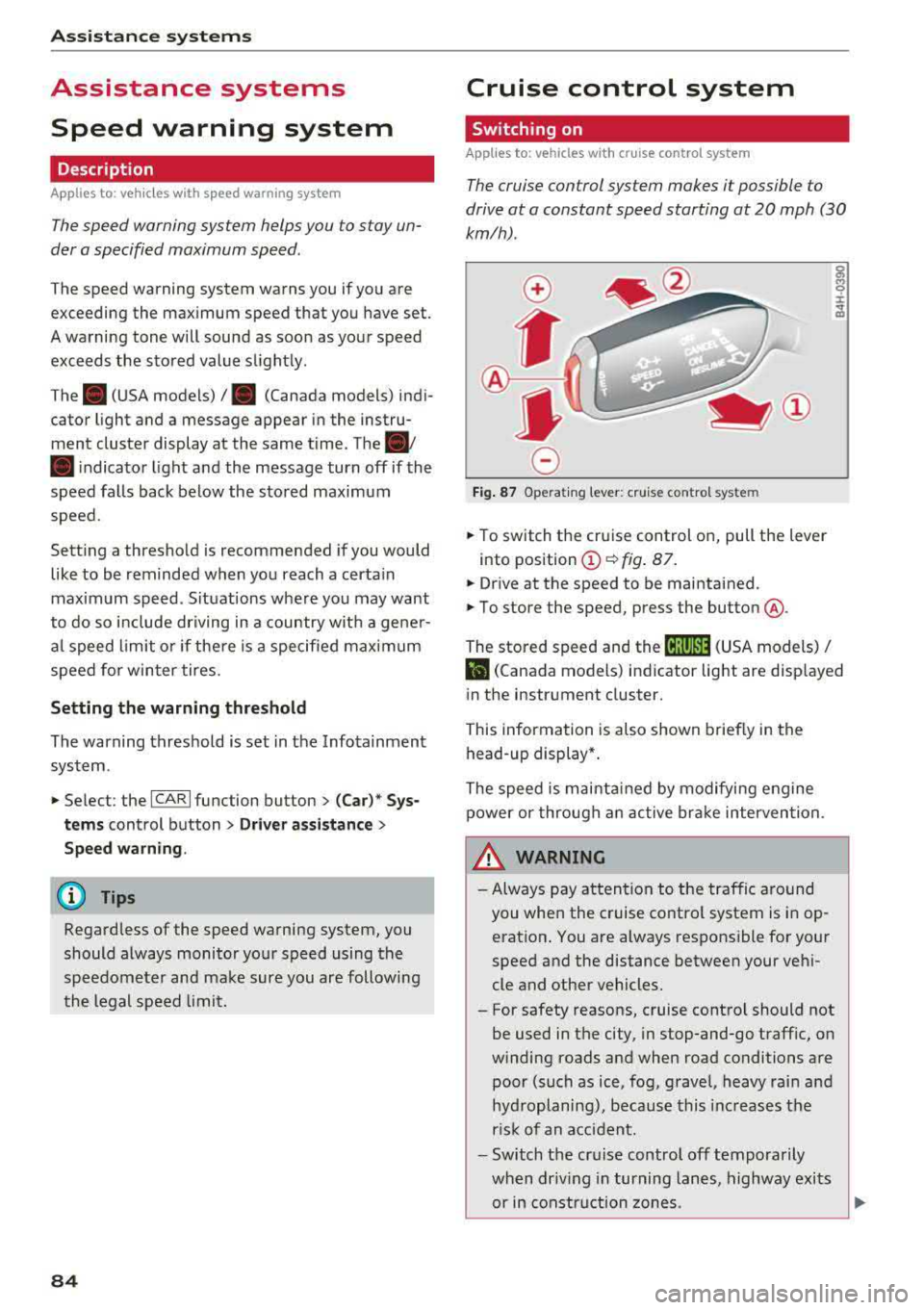
Ass is tance sy stem s
Assistance systems
Speed warning system
Description
Applies to: veh icles with speed warning system
The speed warning system helps you to stay un
der a specified maximum speed.
The speed warning system warns you if you are
exceeding the maximum speed that you have set.
A warning tone will sound as soon as your speed
exceeds the sto red value slightly.
The . (USA models) I. (Canada models) indi
cator light and a message appear in the instru
ment cluster display at the same time.
The.
• indicator light and the message turn off if the
speed falls back below the stored maximum
speed.
Sett ing a threshold is recommended if you would
like to be reminded when you reach a certa in
maximum speed. S ituations where you may want
to do so i nclude driving in a country wit h a ge ne r
a l speed limit o r if the re is a specified maximum
speed for winter tires.
Setting the warning threshold
The warning threshold is set in the Infotainment
system.
• Se lect: the ICARI function button> (Car )* Sys
tems
control button > Driver assistan ce >
Spe ed warning .
(D Tips
Regardless of the speed warning system, you
should always monitor your speed using the
speedometer and make sure you are following
the legal speed limit.
84
Cruise control system
Switching on
Applies to: vehicles with cruise control system
The cruise control system makes it possible to
drive at a constant speed starting at 20 mph (30
km/h).
0
f
~
0
F ig . 8 7 Operat ing lever: c ruise control system
• To switch t he cru ise control o n, pull the lever
into position
(D ~ fig. 87 .
• Drive at the speed to be maintained.
• To store the speed, press the button @.
The stored speed and the
( ij;\1)~14 (USA models) /
l'I (Canada models) ind icator lig ht are disp layed
in the instrument cluster.
This information is also shown briefly in the
head -up display* .
The speed is mainta ined by modifying engine
power or through a n active br ake interven tion.
~ WARNING
-Always pay at tentio n to the traffic around
you when the cruise contro l system is in op
eration . You are always respons ible for your
speed and the distance between your ve hi
cle and other vehicles.
-For safety reasons, cruise control should not
be used in the city, in stop-and-go traff ic, on
winding roads and when road conditions are poor (such as ice, fog, gravel, heavy rai n and
hyd roplaning), because this inc reases the
r is k of an accident.
-Switch the cr uise control off temporarily
when dr iv ing in turning lanes, highway exits
or in constr uction zones.
-
Page 125 of 266

a co .... N
" N .... 0 0 \,;J '
Applies to: vehicles wit h all wheel drive
In oil wheel drive, oil four wheels ore powered .
General information
In all wheel drive, the driving power is divided be
tween all four wheels. This happens automatical
l y depending on your driving behavior as well as
the current road conditions. Also see
c:> page 119, Electronic stabilization control
(ESC) .
A center differential distributes the driving power
variab ly to the front and rear axle. It works to
gether with selective wheel torque control, which
activates when driving through curves
c:>poge 119. With the sport differential*, power
distribution to the rear wheels is variable and can
be adjusted w ith drive select
c:> poge 104 .
The all wheel drive concept is designed for high
engine power. Your vehicle is exceptionally pow
erful and has excellent driving characteristics
both under normal driv ing cond itions and on
snow and ice. Always read and fo llow safety pre
cautions
c:> .&, .
Winter tires
By using all wheel drive, your vehicle has good
forward mot ion with standard tires in winter con
ditions . However, in winter we recommend using
winter or all season tires on all four w heels, be
cause this will improve the braking effect.
Snow chains
If there are snow chain laws, snow chains must
also be used on vehicles with all wheel drive
c:> page 217, Snow chains.
Replacing tires
For vehicles with all wheel drive, only wheels with
the same rolling circumference should be used .
Avoid using tires with different tread depths
c:> page 208, New tires or wheels .
Offroad vehicle?
Your Audi is not an offroad vehicle -there is not
enough ground clearance. For this reason, avoid
difficult terrain.
Intelligent Technology
A WARNING
--
- Also, in veh icles with all wheel drive, adapt
your driving style to the current road and
traffic conditions . Do not let the increased
safety provided tempt you into taking risks,
because this increases the risk of an acci
dent.
- The braking ability of your vehicle is limited
to the traction of the wheels. In this way, it
is not different from a two wheel drive vehi
cle. Do not be tempted to accelerate to a
high speed when the road is slippery, be
cause t his increases the risk of an accident .
- Note that on wet streets, the front wheels
can "hydrop lane" if driving at speeds that
are too high. Unlik e front wheel drive
veh icles, the engine does not rev higher sud
denly when the vehicle begins hydroplaning.
For this reason, adapt your speed to the
road conditions to reduce the risk of an acci
dent.
Energy management
Your vehicle is equipped with an intelligent ener
gy management system for distributing electrici
ty . This significantly improves the start ing ability
and increases the vehicle battery life.
(D Tips
- If you dr ive short distances frequently, the
veh icle battery may not charge enough
w hile driving. As a result, convenience func
tions for electr ical equipment may be tem
porarily unavailable.
- Th e vehicle battery w ill gradually drain if
the vehicle is not driven for long periods of
time, or if electrical equipment is used
when the engine is not running. To ensure
that the vehicle can still be started, the
electrical equipment will be reduced or
switched off.
123
Page 203 of 266
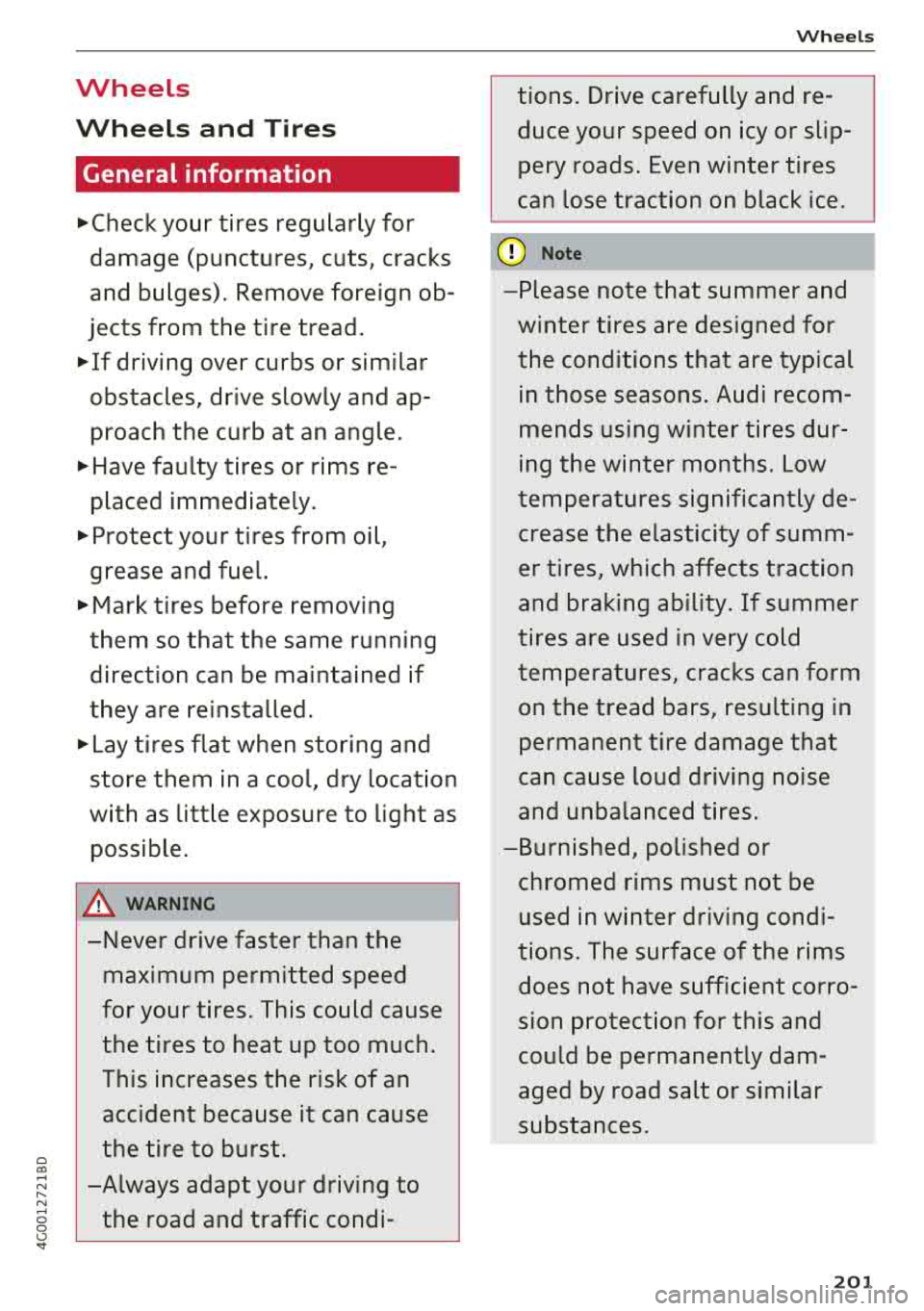
0 0)
-N ,.... N
-0
s ..
Wheels
Wheels and Tires
General information
.,,.Check your tires regularly for
damage (punctures, cuts, cracks
and bulges). Remove foreign ob
jects from the tire tread.
.,,. If driving over curbs or similar
obstacles, drive slowly and ap
proach the curb at an angle.
.,,.Have faulty tires or rims re
placed immediately.
.,,.Protect your tires from oil,
grease and fuel.
.,,.Mark tires before removing
them so that the same running
direction can be maintained if
they are reinstalled.
.,,.Lay tires flat when storing and
store them in a cool, dry location
with as little exposure to light as
possible.
&_ WARNING -
-Never drive faster than the
maximum permitted speed
for your tires. This could cause the tires to heat up too much.
This increases the risk of an
accident because it can cause
the tire to burst.
-Always adapt your driving to the road and traffic condi-
Wheels
tions. Drive carefully and re
duce your speed on icy or slip
pery roads. Even winter tires
can lose traction on black ice .
@ Note
-Please note that summer and
winter tires are designed for
the conditions that are typical
in those seasons. Audi recom
mends using winter tires dur
ing the winter months. Low
temperatures significantly de crease the elasticity of summ
er tires , which affects traction
and braking ability. If summer
tires are used in very cold
temperatures, cracks can form on the tread bars, resulting in
permanent tire damage that
can cause loud driving noise
and unbalanced tires.
-Burnished, polished or chromed rims must not be
used in winter driving condi
tions. The surface of the rims does not have sufficient corro
sion protection for this and
could be permanently dam
aged by road salt or similar
substances.
201
Page 205 of 266
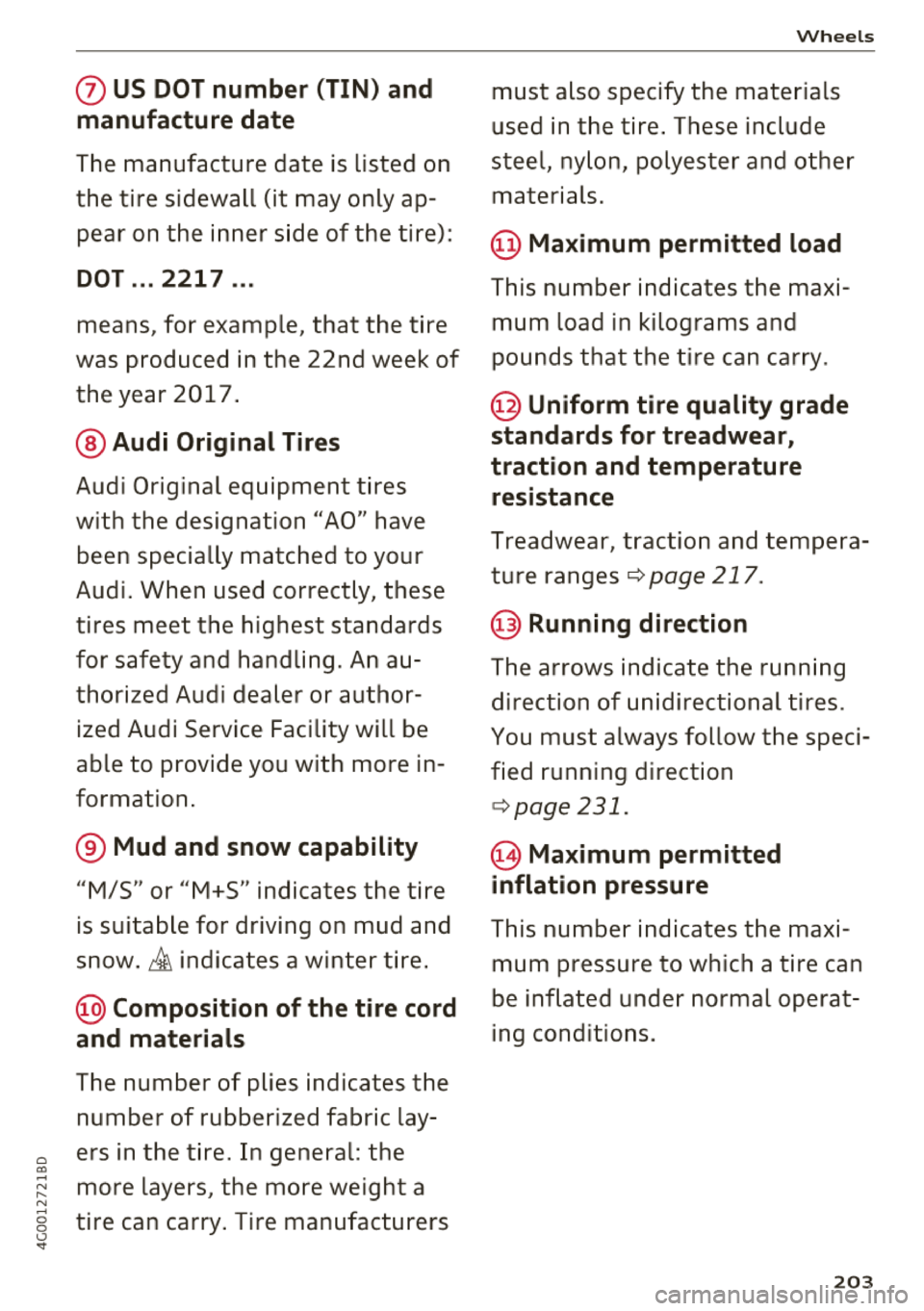
0 0)
-N ,.... N
-0
s ..
(J) US DOT number (TIN) and
manufacture date
T he manufacture date is listed on
the tire sidewall (it may only ap
pear on the inner s ide of the tire):
DOT .. . 2217 .. .
means , for example, that the tire
was produced in the 22nd week of
the year 2017 .
@ Audi Original Tires
Audi Original equipment tires
with the designation
"AO" have
been specially matched to your
Audi . When used correct ly , these
tires meet the highest standards
for safety and handling . An au
thorized Audi dealer or author
ized Audi Service Facility wi ll be
able to provide you with more in
formation .
® Mud and snow capability
"M/5 " or "M+S" indicates the tire
is suitable for driving on mud and
snow .
& indicates a winter tire .
@ Composition of the tire cord
and materials
The number of plies indicates the
number of rubberized fabric lay
ers in the tire. In general : the
more layers, the more we ight a
tire can carry . Tire manufacturers
Wh eel s
must also specify the materials
used in the tire . These include
steel, nylon, polyester and other
materials.
@ Ma ximum permitted load
This number indicates the maxi
mum load in kilograms and
pounds that the tire can carry .
@ Uniform tire qual ity grade
standards for treadwear,
traction and temperature resistance
Treadwear , tract ion and tempera
ture ranges
r=:>page217 .
@ Running direction
The arrows indicate the runn ing
direction of unidirectional tires .
You must always follow the speci
fied running direction
Q page 231.
@ Ma ximum permitted
inflation pressure
This number indicates the maxi
mum pressure to which a tire can
be inflated under normal operat
ing cond itions .
203
Page 211 of 266

0 0)
-N ,.... N
-0
s ..
differently even if they are the
same
size ¢,&. .
.,,. If you would like to equip your
vehicle with a tire/rim combina
tion that is different from what
was installed at the factory, con
sult with an authorized Audi
dealer or authorized Audi Service
Facility before making a pur
chase¢ ,&..
Because the spare tire* is differ
ent from the regular tires instal
led on the vehicle (such as winter
tires or wide tires), only use the spare tire* temporarily in case of
emergency and drive carefully
while it is in use. It should be re
placed with a regular tire as soon
as possible.
Applies to: vehicles with all wheel drive : all four wheels must be
equipped with tires that are the
same brand and have the same
construction and tread pattern so
that the drive system is not dam aged by different wheel speeds.
For this reason, in case of emer
gency, only use a spare tire* that
is the same circumference as the
regular tires .
Wheels
A WARNING
-Do not use steel rims that are
17 inches or larger. Other
wise, damage to the vehicle and an accident could result.
-Only use tire/rim combina
tions and suitable wheel bolts
that have been approved by
Audi. Otherwise, damage to
the vehicle and an accident
could result.
-For technical reasons, it is not
possible to use tires from oth
er vehicles
-in some cases,
you cannot even use tires from
the same vehicle model.
-Make sure that the tires you
select have enough clearance
to the vehicle. Replacement
tires should not be chosen
simply based on the nominal
size, because tires with a dif
ferent construction can differ
greatly even if they are the
same size. If there is not
enough clearance, the tires or
the vehicle can be damaged
and this can reduce driving
safety and increase the risk of
an accident.
...
209
Page 218 of 266
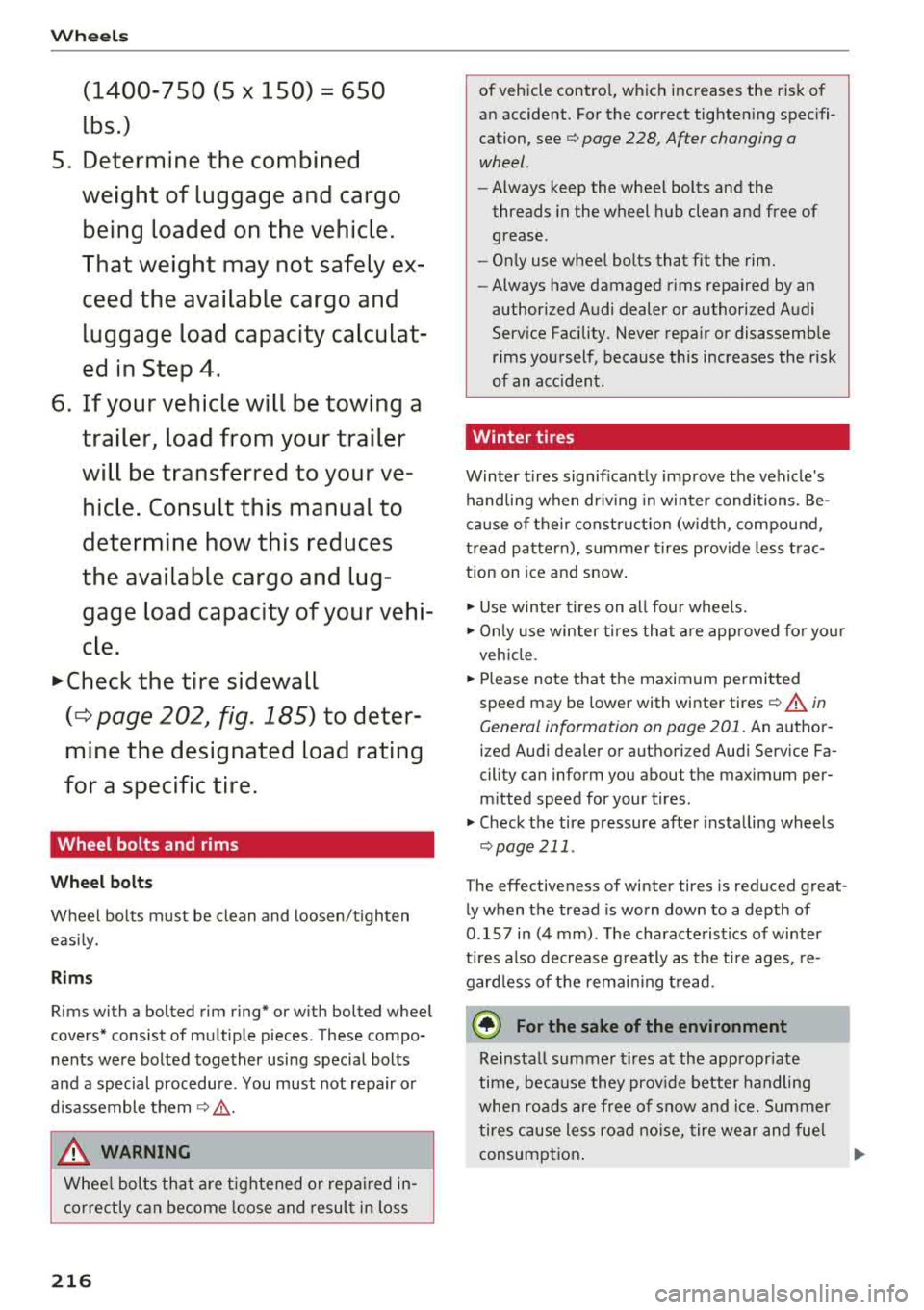
Wheels
(1400-750 (5 X 150) = 650
lbs.)
5 . Determin e the combined
w eig ht of lu ggage and cargo
b e in g load ed on the vehicle .
Th at w eight ma y not safel y ex
ce ed the avail abl e ca rg o and
lug gag e lo ad capac it y ca lculat
ed in St ep 4 .
6. If your vehi cle will be to wing a
tr aile r, lo ad fr om your tr ailer
w ill be transferred to your
ve
hicle . Con sult thi s manual to
d etermin e how thi s re du ces
th e av ail ab le carg o and lug
g age load capa cit y o f your v ehi
cle .
.,. Chec k the tir e s idewall
(c:::> pa ge 202 , fig . 185) to det er
min e the de sign ated load r ating
for a speci fic tire .
Wheel bolts and rims
Wheel bolts
Wheel bo lts must be clean and loosen/t ighten
eas ily.
Rims
Rims with a bolted rim ring* or w it h bolted whee l
covers* consist of mu ltip le pieces . These compo
nents we re bolted together using specia l bolts
a nd a special procedure . You must not repair or
d isassemble
them ¢_&. .
_& WARNING
Whee l bol ts th at ar e tightened o r rep air ed in
c orrectly c an become loose and resul t in loss
216
of vehicle contro l, w hich increases the risk o f
an accident. For the cor rect tig hten ing spec ifi
cation,
see¢ page 228, After changing a
wheel.
- Always keep the whee l bolts and the
threads in the wheel hub clean and free of
grease .
- Onl y use whee l bolts that fit the rim.
- Always have damaged rims repaired by an
author ized Audi dealer or authorized Audi
Serv ice Facility. Never repa ir or disassemb le
r ims yo urself, because th is increases the risk
of an acc ident.
Winter tires
Winter t ires signif icant ly imp rove the vehicle's
handling when dr iv ing in winter conditions. Be
c au se of their construct io n (w id th, compou nd,
t read pa ttern), s ummer tires prov ide less t rac
tion on ice and snow .
.,. Use winter tires on all four wheels.
.,. Only use winter tires that a re app roved fo r yo ur
veh icle .
.,. Please note that t he maximum permitted
speed may be lower with winter
tir es ¢ A in
G en eral information on pag e 201 .
An a uthor
i z ed Aud i dealer or authori zed Aud i Serv ice Fa
cility can inform you about the maximum per m itted speed for your tires .
.,. Check the tire pressure after installing wheels
ca:;, page 211 .
The effectiveness of winter tires is reduced great
ly when the tread is worn down to a depth of
0 .157 i n (4 mm) . The characte rist ics of winter
t ir es also decrease g reatly as the t ire ages , re
gard less of t he rema ining t read.
@ For the sake of the environment
Re insta ll summer t ires at the app ropr iate
time, bec ause they prov ide better handli ng
when ro ads are free of snow and ice. Summer
tires cause less roa d noise, tire wear and fue l
consumpt ion .
Page 219 of 266
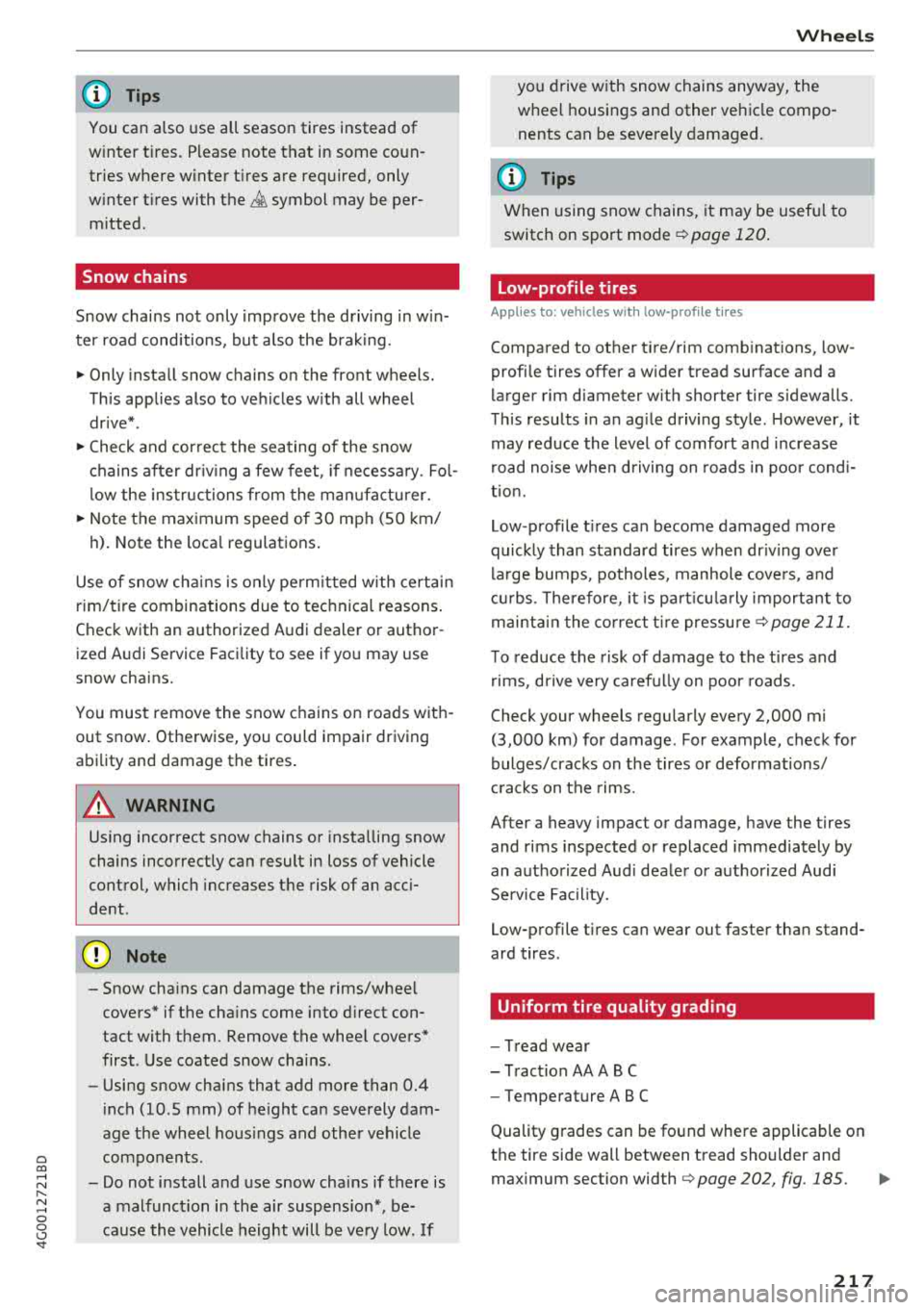
a co .... N
" N .... 0 0 \,;J '
You can also use all season tires instead of
winter tires . Please note that in some coun
tries where winter tires are required, only
winter tires with
the ~ symbol may be per
mitted.
Snow chains
Snow chains not only improve the driving in win
ter road conditions, but also the braking .
.. Only install snow chains on the front wheels.
This applies also to vehicles with all wheel
drive* .
.. Check and correct the seating of the snow
chains after dr iv in g a few feet, if necessary . Fol
low the instructions from the manufacturer .
.. Note the maximum speed of 30 mph (SO km/
h). Note the loca l regulations.
Use of snow chains is only perm itted with certain
rim/tire combinations due to technical reasons.
Check with an authorized Audi dealer or author
ized Audi Service
Facility to see if you may use
snow chains.
You must remove the snow chains on roads with
out snow. Otherwise, you could impair driving
ability and damage the tires.
A WARNING
Using incorrect snow chains or installing snow
chains incorrectly can result in loss of vehicle
control, which increases the risk of an acci
dent .
{[J) Note
- Snow chains can damage the rims/wheel
covers* if the chains come into direct con
tact with them . Remove the wheel covers*
first . Use coated snow chains.
- Using snow chains that add more than 0.4
inch (10.5 mm) of height can severely dam
age the wheel housings and other vehicle
components.
- Do not install and use snow chains if there is
a malfunction in the air suspension*, be
cause the vehicle height will be very low. If
Wheels
you drive with snow chains anyway, the
wheel housings and other vehicle compo
nents can be severely damaged.
(D Tips
When using snow chains, it may be useful to
switch on sport
mode¢ page 120.
Low-profile tires
Applies to: vehicles with low-profile tires
Compared to other tire/rim combinations, low
profile tires offer a wider tread surface and a
larger rim diameter with shorter tire sidewalls.
This results in an agile driving style . However, it
may reduce the level of comfort and increase
road noise when driving on roads in poor condi
tion.
Low -profile tires can become damaged more
quickly than standard tires when driving over
large bumps, potholes, manhole covers , and
curbs . Therefore, it is particularly important to
maintain the correct tir e pressure
¢ page 211.
To reduce the risk of damage to the tires and
rims, drive very carefully on poor roads.
Check your wheels regularly every 2,000 mi
(3,000 km) for damage . For example, check for
bulges/cracks on the tires or deformations/
cracks on the rims.
After a heavy impact or damage, have the tires
and rims inspected or replaced immediately by
an authorized Audi dealer or authorized Audi
Service Facility.
Low-profile tires can wear out faster than stand
ard tires .
Uniform tire quality grading
-Tread wear
- Traction AA ABC
- Temperature ABC
Quality grades can be found where applicable on
the tire side wall between tread shoulder and maximum section width
¢ page 202, fig. 185 .
217
Page 235 of 266
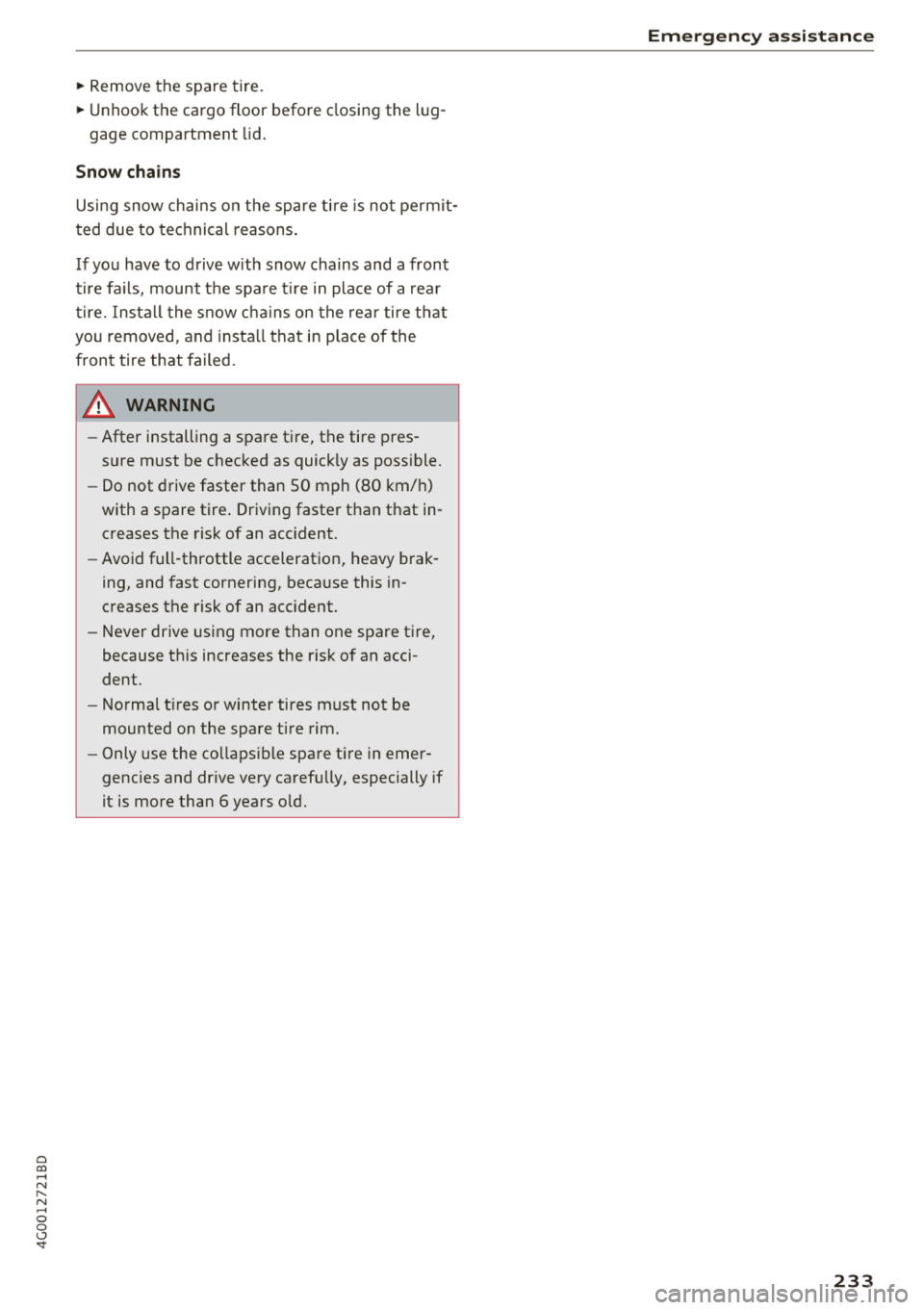
a co .... N
" N .... 0 0 \.J '
~ Unhook the cargo floor before closing the lug-
gage compartment lid .
Snow chains
Using snow chains on the spare tire is not pe rmit
ted due to technical reasons.
I f you have to drive with snow chains and a front
tire fa ils, mount the spa re t ire in place of a rea r
tire. Install the snow cha ins on the rear tire that
you removed , and insta ll that in place of the
front tire that failed.
A WARNING
-
- After installing a spare tire, the tire pres
sure must be checked as quickly as possible.
- Do not drive faster than SO mph (80 km/h)
with a spare tire . Driving faster than that in
creases the risk of an acc ident.
- Avoid full-throttle acceleration, heavy brak
ing, and fast cornering, because this in
creases the risk of an acc ident.
- Never drive using more than one spare tire,
because this increases the risk of an acci
dent .
- Norma l t ires or winter tires must not be
mounted on the spare tire rim.
- Only use the co llapsible spare tire in emer
gencies and dr ive very carefully, especially if
it is more than 6 years o ld.
Em ergenc y ass is tanc e
233